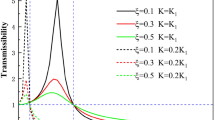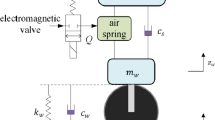Abstract
To reduce effects of vibration of commercial vehicles during driving, this paper proposes a new semi-active quasi-zero stiffness air suspension to improve vibration isolation and a strategy for negative stiffness control, which guarantees commercial vehicles owning excellent vibration isolation performance under different driving conditions. The strategy is mainly composed of data driven approach and adaptive fuzzy neural network method. Firstly, support vector machine (SVM) is adopted to identify road condition. The load, speed and air pressure signals collected by sensors and indirectly obtained suspension dynamic deflection data are imported into the SVM model trained by data to obtain-specific road conditions. Then, with the obtained road condition, the optimal air pressure of the pneumatic linear actuators is searched, which decides the negative stiffness of the system and is later the target pressure. Adaptive fuzzy neural network which trained by large amount of data is used in the air pressure seeking process to make sure that the target air pressure of any driving condition is suitable. Finally, active disturbance rejection controller (ADRC) is applied to realize tracking control of target air pressure. Parameters of ADRC are set to adapt to variable driving conditions. The results of Hardware-in-Loop (HiL) tests indicate that the negative stiffness control strategy can effectively improve multi-objective performance of commercial vehicles under different driving conditions.













Similar content being viewed by others
Explore related subjects
Discover the latest articles, news and stories from top researchers in related subjects.References
Moheyeldein, M.M., Abd-El-Tawwab, Ali M., Abd El-gwwad, K.A., Salem, M.M.M.: An analytical study of the performance indices of air spring suspensions over the passive suspension. Beni-Suef Univ. Jo. Basic Appl. Sci. 7, 525–534 (2018)
Xu, X., Chen, L., Sun, L., Sun, X.: Dynamic ride height adjusting controller of ECAS vehicle with random road disturbances. Math. Probl. Eng. 2013, 1–9 (2013)
Ma, X., Wong, P.K., Zhao, J., Zhong, J.H., Ying, H., Xu, X.: Design and testing of a nonlinear model predictive controller for ride height control of automotive semi-active air suspension systems. IEEE Access 1 (2018)
Li, H., Li, S., Sun, W., Wang, L., Lv, D.: The optimum matching control and dynamic analysis for air suspension of multi-axle vehicles with anti-roll hydraulically interconnected system. Mech. Syst. Signal Process. Autom. 106605 (2020)
Qi, H., Chen, Y., Zhang, N., Zhang, B., Wang, D., Tan, B.: Improvement of both handling stability and ride comfort of a vehicle via coupled hydraulically interconnected suspension and electronic controlled air spring. Proc. Inst. Mech. Eng. 234, 552–571 (2020)
Zhu, H., Yang, J., Zhang, Y.: Dual-chamber pneumatically interconnected suspension: modeling and theoretical analysis. Mech. Syst. Signal Process. 147, 107125 (2021)
Ma, R., Cuong, D. M.: Comfort-oriented semi-active matching design with a magneto-rheological air suspension mechanism. IJST Trans. Mech. Eng. 45, 699–709 (2020)
Wang, T., Chen, S., Ren, H., Zhao, Y.: State estimation and damping control for unmanned ground vehicles with semi-active suspension system. Proc. Inst. Mech. Eng. D 234, 1361–1376 (2019)
Zhao, J., Wong, P.K., Ma, X., Xie, Z.: Design and analysis of an integrated sliding mode control-two-point wheelbase preview strategy for a semi-active air suspension with stepper motor-driven gas-filled adjustable shock absorber. Proc. Inst. Mech. Eng. I 232, 1194–1211 (2018)
Zhang, H., Zheng, X., Li, H., Wang, Z.: Active suspension system control with decentralized event-triggered scheme. IEEE Trans. Ind. Electron 67, 10798–10808 (2020)
Nieto, A. J., Morales, A. L., Chicharro, J. M., Pintado, P.: An adaptive pneumatic suspension system for improving ride comfort and handling. J. Vib. Control 22, 1492–1503 (2016)
Li, I.H.: Design for a fluidic muscle active suspension using parallel-type interval type-2 fuzzy sliding control to improve ride comfort. Int. J. Fuzzy Syst. (2022)
Abbasi, A. Khadem, S., Bab, S.: Vibration control of a continuous rotating shaft employing high-static low-dynamic stiffness isolators. J. Vib. Control 24, 760–783 (2018)
Yuan, S., Sun, Y., Zhao, J., Meng, K., Wang, M., Pu, H., Peng, Y., Luo, J., Xie, S.: A tunable quasi-zero stiffness isolator based on a linear electromagnetic spring. J. Vib. Control 482, 115449 (2020)
Jiang, Y., Song, C., Ding, C., Xu, B.: Design of magnetic-air hybrid quasi-zero stiffness vibration isolation system. J. Sound Vib. 477, 115346 (2020)
Zhou, J., Xiao, Q., Xu, D., Ouyang, H., Li, Y.: A novel quasi-zero-stiffness strut and its applications in six-degree-of-freedom vibration isolation platform. J. Sound Vib. 394, 59–74 (2017)
Palomares, E., Nieto, A.J, Morales, A.L., Chicharro, J.M., Pintado, P.: Numerical and experimental analysis of a vibration isolator equipped with a negative stiffness system. J. Sound Vib. 414, 31-42 (2018)
Yan, G., Zou, H.X., Wang, S., Zhao, L.C., Zhang, W.M.: Large stroke quasi-zero stiffness vibration isolator using three-link mechanism. J. Sound Vib. 478, 115344 (2020)
Le, T.D., Ahn, K.K.: Experimental investigation of a vibration isolation system using negative stiffness structure. Int. J. Mech. Sci. 70, 99–112 (2013)
Sun, X., Yuan, C., Cai, Y., Wang, S., Chen, L.: Model predictive control of an air suspension system with damping multi-mode switching damper based on hybrid model. Mech. Syst. Signal Process. 94, 94–110 (2017)
Zepeng, G., Jinrui, N., Lian, L., Xiaolin, X.: Research on air suspension control system based on fuzzy control. Energy Procedia 105, 2653–2659 (2017)
G. P. S., M. M. K.: A contemporary adaptive air suspension using lqr control for passenger vehicles. ISA Trans. 93, 244-254 (2019)
Min, X., Li, Y., Tong, S.: Adaptive fuzzy output feedback inverse optimal control for vehicle active suspension systems. Neurocomputing 403, 257–267 (2020)
Han, S.Y., Zhong, X.F., Chen, Y.H., et al.: Fuzzy Guaranteed Cost \(H\infty\) Control of uncertain nonlinear fuzzy vehicle active suspension with random actuator delay. Int. J. Fuzzy Syst. 21, 2021–2031 (2019)
Li, Q., Pan, Y., Liang, H.: A switching control approach for uncertain vehicle suspension systems with actuator failure. Int. J. Fuzzy Syst. 23, 322–333 (2021)
Tong, S., Sun, K., Sui, S.: Observer-based adaptive fuzzy decentralized optimal control design for strict-feedback nonlinear large-scale systems. IEEE Trans. Fuzzy Syst. 1-1 (2018)
Li, Y., Liu, Y., Tong, S.: Observer-based neuro-adaptive optimized control of strict-feedback nonlinear systems with state constraints. IEEE Trans. Neural Netw. Learn. (99), 1–15 (2021)
Li, Y., Zhang, J., Tong, S.: Fuzzy adaptive optimized leader-following formation control for second-order stochastic multi-agent systems. IEEE Trans. Ind. Inform. 1 (2021) https://doi.org/10.1109/TII.2021.3133927.
Ding, R., Wang, R., Meng, X., Liu, W., Chen, L.: Intelligent switching control of hybrid electromagnetic active suspension based on road identification. Mech. Syst. Signal Process. 152, 107355 (2021)
Khan, M., Reza, M. Q., kumar Salhan, A.: Classification of oils by ecoc based multi-class svm using spectral analysis of acoustic signals. Appl. Acoust. 183, 108273 (2021)
Phu, D. X., Mien, V.: Robust control for vibration control systems with dead-zone band and time delay under severe disturbance using adaptive fuzzy neural network. J. Franklin Inst. 357, 12281–12307 (2020)
Han, J.: From pid technology to “active disturbance rejection control” technology. Control Eng. 9, 13–18 (2002) (in Chinese)
Acknowledgements
This work was supported by the National Natural Science Foundation of China under (Grant No. 51875256) and Open Platform Fund of Human Institute of Technology (KFA20009) and Hong Kong, Macao and Taiwan Science and Technology Cooperation Project in Jiangsu Province (BZ2020050).
Author information
Authors and Affiliations
Corresponding author
Rights and permissions
About this article
Cite this article
Ma, Z., Xu, X., Xie, J. et al. Negative Stiffness Control of Quasi-Zero Stiffness Air Suspension via Data-Driven Approach with Adaptive Fuzzy Neural Network Method. Int. J. Fuzzy Syst. 24, 3715–3730 (2022). https://doi.org/10.1007/s40815-022-01357-1
Received:
Revised:
Accepted:
Published:
Issue Date:
DOI: https://doi.org/10.1007/s40815-022-01357-1




